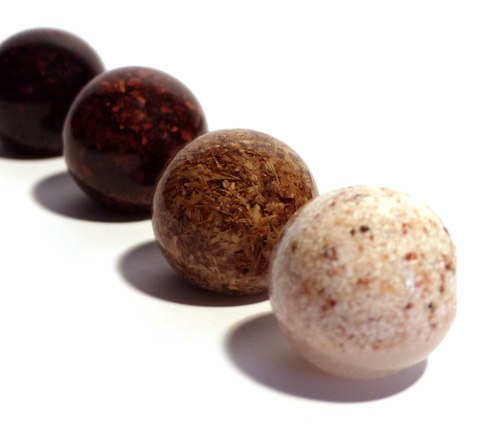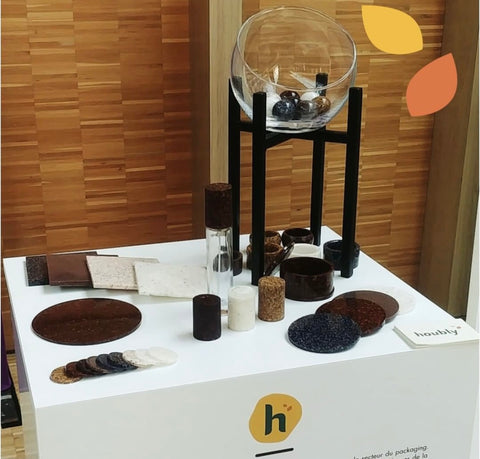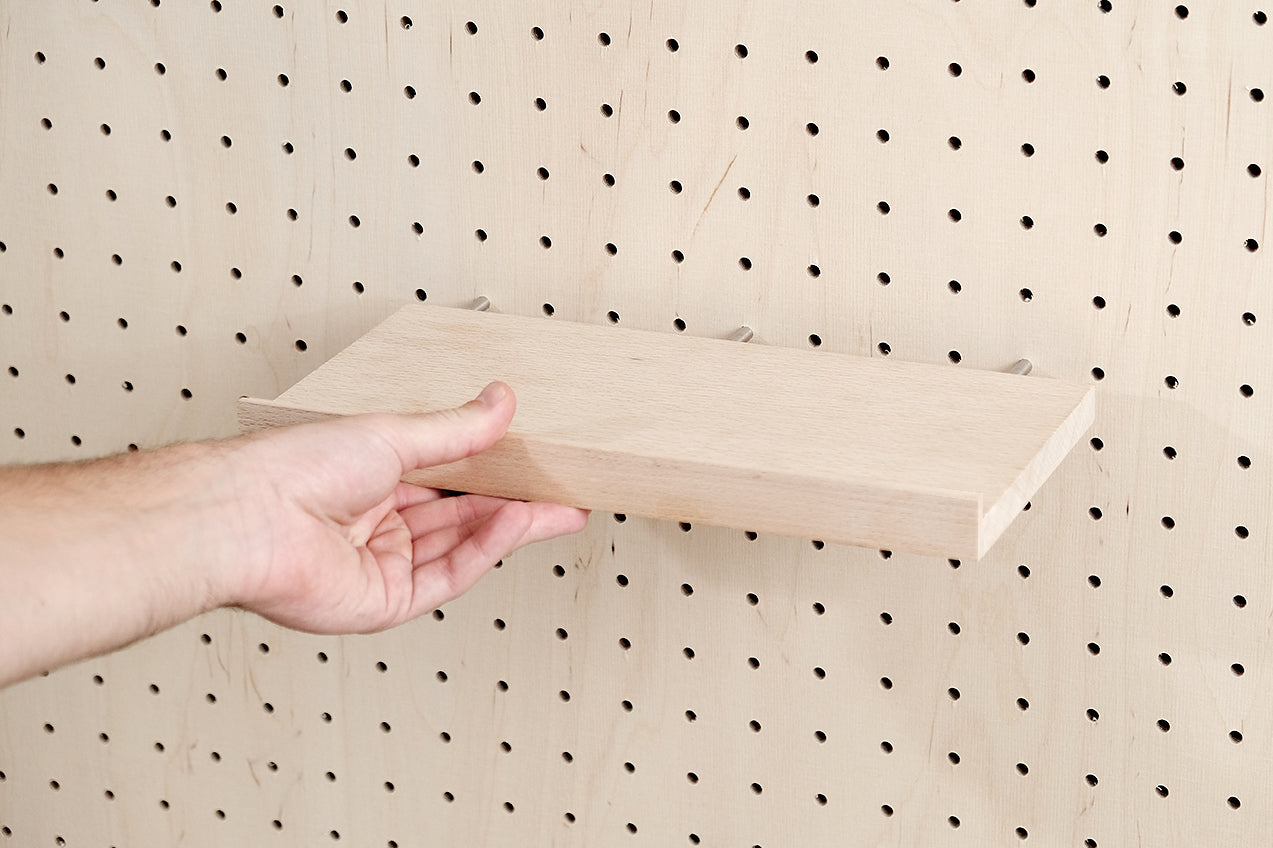Aire went to meet one of the co-founders of the company HOUBLY. Manon Baste and Auriane Lefebvre's goal is to create innovative materials. Indeed, they joined forces with a common environmental objective: to reduce our waste with bio-sourced materials from the circular economy . Once again, we are faced with Made In France!
Can you introduce yourself?
My name is Auriane Lefebvre , I'm 29 years old and with Manon we founded HOUBLY . But before that I had another life because I graduated from business school in strategy and marketing. Then, I worked for more than three years as a digital transformation consultant for businesses.

Even though I learned a lot in this profession, it wasn't something that suited me. It was very far from my personal struggles and commitments. And I wanted to work on topics that really motivate me and that are crucial for the future of society with bio-sourced materials .
Was there a trigger for this life as a bio-sourced materials entrepreneur?
It came gradually. I started thinking in my personal life, in my student studio, “My trash takes up more space than anything else in my kitchen.” I realized that this wasn’t normal. So I asked myself what I could do to reduce the amount of waste .
Then I became interested in zero waste, starting with the bathroom. Then I did it for my kitchen. After that, I started changing my diet.

I took action little by little. Then, when I completed the steps, I wanted to do more and more.
In my personal life, I'm involved in an association that organizes events in support of societal and environmental transitions. I realized I had to get involved because I felt motivated by these issues. In addition, my personal and community involvement was no longer sufficient. So I wanted to join a company that aligned with my values. Or create one that reflected my image.
The meeting with Manon and bio-sourced materials
It was my meeting with Manon that changed everything. I was trained in these subjects (sustainable development, circular economy, eco-design). I was looking at companies that could correspond to my values and that took environmental and societal issues into account. I was looking for what role I could play, what skills I could bring to them. Then during this research I came across Manon.

She had posted a short message saying she had an idea for bio-based materials and didn't know how to develop it. So she was looking for someone to potentially partner with.
We had the same thoughts: waste that comes from nature is not waste.

So it was obvious when she told me about her idea of reusing natural waste to create raw materials using bio-sourced materials . We each explained our points of view on the project, and we had a common long-term vision. In addition, we had the same major steps to get to this end. We get along well, we have the same vision of the project, we analyze the same problem and the same observation. So the collaboration should work well. So, we collaborated from January to August. We matched even if we were different. This allows us to complement each other on a lot of things. So in September we created the company.
Where are you with your bio-sourced materials projects?
Our project has evolved a lot since we started. At the very beginning, the project was to use waste from beer brewed at festivals. This was used to make compostable furniture with a very short lifespan. So, we thought about this idea, we said to ourselves that it took energy. Even if they are natural, low-tech, but in the short term. So it wasn't a good long-term recovery solution . So, we thought about the whole project.

Our goal when we started working together was to make bio-sourced materials from this biowaste. We use the intrinsic qualities of this waste, but also its visual appeal. We wanted low-tech, natural, bio-sourced, and visually interesting materials. It's an innovation that's still ongoing. Because in reality, it could have been very simple by mixing our biowaste with wood glue or something else. It works. But the environmental approach isn't advanced enough. We want to go further and all the way. We don't want to take this easy solution. So we invested in R&D. We thought about how we could replace this glue. Especially since we've been thinking about the end of the product's life from the beginning. The first observation was the amount of waste that has no other life after arriving at the recycling center. It's either buried or incinerated. And we didn't want to contribute to that. That's why it's taking time and it's still ongoing.
R&D
On the other hand, we did our utmost in terms of R&D, so we surrounded ourselves with experts in biochemistry, agromaterials, etc. We partnered with a laboratory to do the research and recruited our first intern. This took away several daily responsibilities. Given the time the research would take, and the motivation we had, we told ourselves that we shouldn't waste the time we were delegating. So we looked for what we could invest in. So we wondered if there weren't other hypotheses we could test in our basement. Since we don't have any machines, the research was very low-tech and artisanal. But today we've developed a process for bio-sourced materials that seems to work well. We're currently doing fire tests, for example. We take the product, a blowtorch, and see if it burns. Because, yes, you have to start somewhere.

It's important to have an idea of the characteristics of our bio-sourced materials before we start marketing them and in order to answer customers' questions. Because we know very well what questions people will have when they see this product: is it resistant to humidity, fire? All of this is starting to come to an end and we will be able to start marketing small objects sourced from biowaste, very artisanal and low-tech.
What are your roles in the company?
We created a simplified joint-stock company (SAS), so we absolutely needed a president and a general manager. So these are the roles we have in the statutes. In reality, Manon has a design degree and is trained in eco-design. I have a degree in marketing strategy. So we divided up the tasks. Manon takes care of everything related to production. I take care of development and marketing.

Overall, we touch on everything. But we each have our own areas of expertise based on our experiences and studies. It would be a waste of time to be together all the time, so we still divide up the tasks while staying informed on both sides.
Your typical day?
I usually start very early and finish very late! But I always start with emails, checking in on our partners and our intern. I also keep everyone who has supported us (for over a year) up to date. These people can become prospects, so it's important to get their feedback and comments. You have to be sure you're going in the right direction.
Then we make a lot of efforts to succeed in making ourselves known, to ensure that we gain legitimacy . We would like Houbly to be credible and legitimate in these environmental issues with our bio-sourced materials.

Then, like any young business creator, there are a lot of tests and production experiments. For me, that's a fun side. Then there's the essential side of thinking about the business model, strategy, product development, sales, marketing, and communication. All of this changes regularly.
The business plan for new materials
So, there is the construction of this famous business plan . It takes a lot of time in the life of any young entrepreneur. Not only is it important for us, to know which direction to go in. But also because at some point we will have to seek funding. Because until now we are self-financed . But when we have our concept and we really have to launch, we will need a bank loan or other necessary subsidies and aid. We would also really like to work with ADEME. It drives us every day with Manon. Without forgetting the part of our days where we pay attention to everything that is happening around us. Because today we are an innovative company, we must be on the lookout for all the advances. Let's not forget that our dream product according to our specifications does not yet exist. So we must constantly check that we are not heading towards a false good idea.
What makes you dream about these innovative materials?
A world that turns round. Like in a circular economy . Let's tell ourselves that we see things in a much broader, more global way. Let's take our entire ecosystem into account and think about becoming as green as possible. Everyone needs to work together: communities, legal entities, and even individuals.
We all need to think about our impact and think about making a transition.

Do you have any favorite Instagram accounts?
@foranecologicalawakening

It started with a student association, which wanted to create a movement after seeing that environmental issues were not being properly addressed. So they wanted to train themselves on this, raise awareness among others, and do quality work (sometimes much better than some professionals). This association raises awareness and provides a lot of information. Even today, thanks to them, I learn things. We can only congratulate them, since they were recently posted in the Paris metro. This is the ultimate accolade because it is a recognition of their work. In addition, they have made it their mission to expose all the companies that were greenwashing. They do it very intelligently with polite, structured phrases and lots of evidence. It also allows us to question ourselves. Put things into perspective. They explain why we need to go further. They give us all the keys so that we can think for ourselves on different subjects.
@materiae_co

She's someone who showcases different materials. They can be new, innovative, or original. Some have only just arrived on the market. These are beautiful photos. They are beautiful showcases of certain materials. It shows that things are moving a little. But is it because it's our field and we're a little in our own bubble that we have the impression that things are moving? Maybe. But in any case, I appreciate the aesthetic of her Instagram account.
What are the values you want to share with your company?
Manon and I chose three values. It was difficult to choose just three. In any case, the ones that Houbly embodies are:
- Innovation : because we want to demonstrate creativity by going as far as innovation. Never rest on our laurels. We must all work to achieve the expected end result. Moreover, innovation is for us a way of responding to a problem in a virtuous manner.
- The community : We shouldn't work alone in our corner; we'll go further together. It may take more time, but I'm convinced we'll go further.
- Kindness : Sometimes we're aware of our mistakes. But we shouldn't waste our time throwing stones at someone. We need to help each other because we all have our limits and constraints. We need to lift each other up.
These three values are essential for a successful long-term ecological transition. They're the ones that resonate with us personally, and we're glad that Houbly also embraces them.
What are the stages of ecodesign?
To put it simply, ecodesign means thinking about every stage of a product's life. How to reduce its environmental impact. It starts with the product, but today we're going much further than that. It's a reflection that isn't fixed in time. It will evolve based on our knowledge. It's very important to have this idea from the ideation phase.

In 5 years, where do you see Houbly?
Manon and I often think about this. Houbly would like to have found relevant recovery solutions with at least three types of biowaste. The objective is one of three solutions:
- Open our factory;
- Take one more;
- Open a co-factory;

We'd love to be in charge of our own production site. Manon and I have lots of ideas about what we could implement in our factory to reduce our environmental impact. We've also set ourselves a positive social goal . We haven't defined the method yet. But we'd like to create quality jobs.
Does the wasterial speak to you?
Wasterial is a material created by a Lille-based company called EtNISI . They use waste from deconstruction in the construction industry. It's great because it's the sector that generates the most waste. There's some very interesting work being done on the material .

On the other hand, we are different because we really have the objective of sticking to bio-sourced products and thinking about the end of life of our products. So it's not the same project as EtNISI, but it's one of the players we admire a lot. Today, what they're doing is impactful.


0 comments